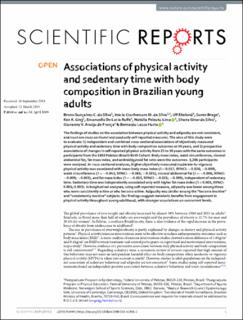Associations of physical activity and sedentary time with body composition in Brazilian young adults
da Silva, Bruna Gonçalves Cordeiro; da Silva, Inácio Crochemore Mohnsam; Ekelund, Ulf; Brage, Søren; Ong, Ken K.; de Lucia Rolfe, Emanuella; Lima, Natália Peixoto; da Silva, Shana Ginar; de Franca, Giovanny V. Araújo; Horta, Bernardo Lessa
Peer reviewed, Journal article
Published version
Permanent lenke
https://hdl.handle.net/11250/2654602Utgivelsesdato
2019Metadata
Vis full innførselSamlinger
- Artikler / Articles [2119]
- Publikasjoner fra Cristin [1107]
Sammendrag
The findings of studies on the association between physical activity and adiposity are not consistent, and most are cross-sectional and used only self-reported measures. The aims of this study were to evaluate: 1) independent and combined cross-sectional associations of objectively-measured physical activity and sedentary time with body composition outcomes at 30 years, and 2) prospective associations of changes in self-reported physical activity from 23 to 30 years with the same outcomes in participants from the 1982 Pelotas (Brazil) Birth Cohort. Body mass index, waist circumference, visceral abdominal fat, fat mass index, and android/gynoid fat ratio were the outcomes. 3,206 participants were analysed. In cross-sectional analyses, higher objectively-measured moderate-to-vigorous physical activity was associated with lower body mass index (β = 0.017, 95%CI: −0.026; −0.009), waist circumference (β = −0.043, 95%CI: −0.061; −0.025), visceral abdominal fat (β = −0.006, 95%CI: −0.009; −0.003), and fat mass index (β = −0.015, 95%CI: −0.021; −0.009), independent of sedentary time. Sedentary time was independently associated only with higher fat mass index (β = 0.003, 95%CI: 0.001; 0.005). In longitudinal analyses, using self-reported measure, adiposity was lower among those who were consistently active or who became active. Adiposity was similar among the “became inactive” and “consistently inactive” subjects. Our findings suggest metabolic benefits from engagement in physical activity throughout young adulthood, with stronger associations on concurrent levels.
Beskrivelse
This article is licensed under a Creative Commons Attribution 4.0 International License, which permits use, sharing, adaptation, distribution and reproduction in any medium or format, as long as you give appropriate credit to the original author(s) and the source, provide a link to the Creative Commons license, and indicate if changes were made. Te images or other third party material in this article are included in the article’s Creative Commons license, unless indicated otherwise in a credit line to the
material. If material is not included in the article’s Creative Commons license and your intended use is not permitted by statutory regulation or exceeds the permitted use, you will need to obtain permission directly from the copyright holder. To view a copy of this license, visit http://creativecommons.org/licenses/by/4.0/.
